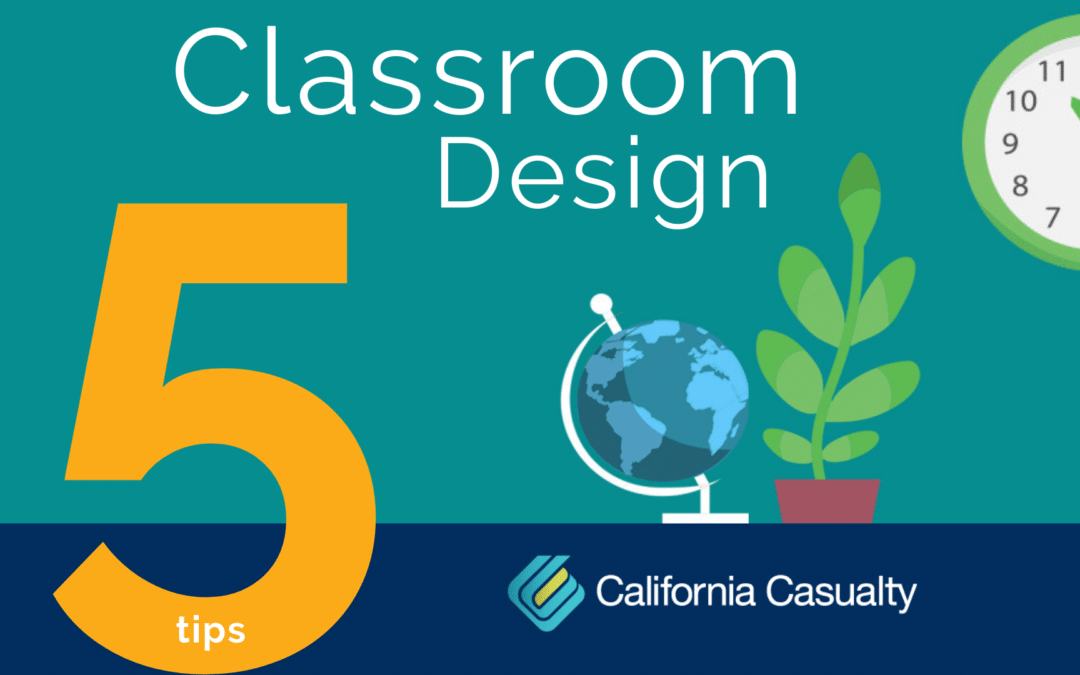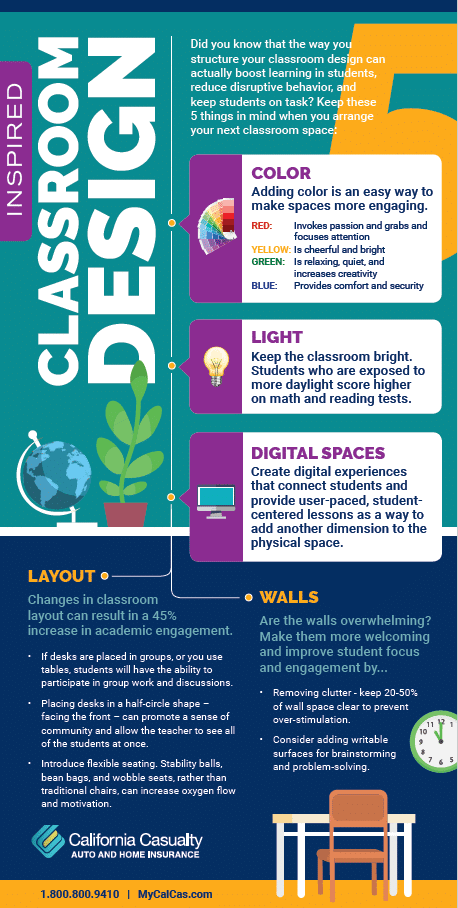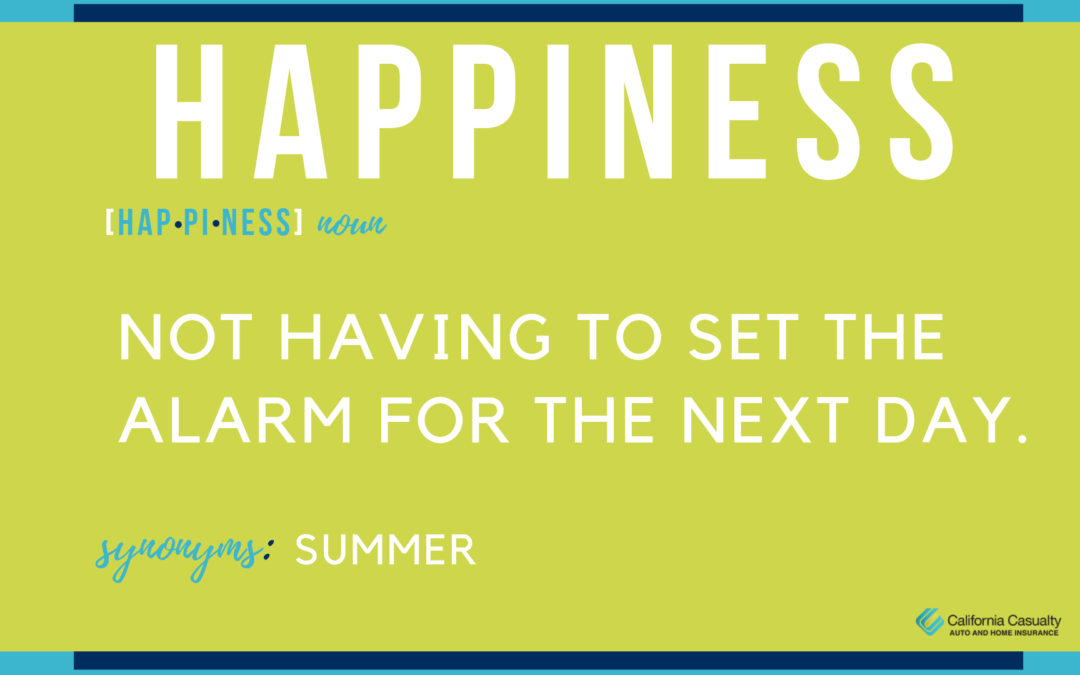
by California Casualty | Educators |
It’s August, which means it’s officially back to school season, and many teachers are working hard in their classroom to get it prepared for that first day!
An organized classroom is an integral part of the learning process. Did you know that the way you structure you classroom design can actually boost learning in students, reduce disruptive behavior, and keep them on task? Behavioral problems in children have been linked back to poor color planning and lighting alone! So, keep these 5 classroom design tips in mind when you organize your space this year:
1. Color
White walls are under-stimulating, while too much color causes over-stimulation. The key to “coloring your classroom” is to find balance and make it comfortable. When using color you want something that is conductive to learning, while positively promoting mental and physical well-being.
For Young Children: Use brighter, warm, colors to draw in their focus on whats going on in the classroom instead of outside, like: yellow, red and orange.
For Older Children: Use calming colors that allow the teenagers to focus on their work, and not their surroundings, like: blue, purple, green, and gray.
If you are able to paint your classroom avoid picking colors that are too bright. Instead pick a more muted shade that will not be distracting. And when you have chosen a color palette do not paint the entire room, instead paint a wall or two and leave the rest neutral. If you’re school does not allow you to paint you could always follow the color scheme you like with your decor. Find posters and create bulletin boards around the color theme you like, and buy furniture for your classroom (like chairs, rugs, storage bins, shelves, etc.) that complement that theme.
2. Light
Harsh lighting can cause headaches and disruptive behavior in students, so it is important to find the proper lighting for your classroom. Research shows that with the right lighting student’s test scores even increase! The key is to use as much natural light as you can, or lights that imitate natural light (aka lights with blue undertones). When students are taking tests, the natural feel helps them relax and focus. If you don’t have enough natural light or you prefer to keep the lights off you can fill up your classroom with lamps, hanging lights, or Christmas lights. Just try and avoid yellow undertones because those tend to make students more fatigued.
3. Digital Spaces
Students today are not just learning in the classroom, they are learning in the digital dimension. It is important for teachers to create digital experiences that connect students and provide-user paced, student-centered lessons as a way to add another dimension to the physical space. Providing resources to students digitally helps teachers build relationships with them. So, to help students feel safe in this space teachers must introduce it, establish rules and norms, and visit it frequently.
STEPS:
- Choose an online system that best suites you and your class
- Create an account and add your students
- Create activities and set aside a specific time for those activities
- Never stop exploring what’s new
Whether you have one online activity, or many, that you do with your students, you should have a spot in your classroom where online activity is represented. Consider a discussion board, or a table that you gather around to view. OR set aside time in the day/week that you do activities on a SMART board or computer together and create in-person activities that go along with them!
4. Layout
Classroom layout can result in a 45% increase in academic engagement. Desk arrangement all comes down to how much space you have, what you think would work best for your class, and how they learn. You could set your students in a:
- Standard spaced out arrangement
- Angled rows
- Modified U or Horseshoe
- Groups
- Combination
Or choose one layout and then mix it up every quarter!
Another option is flexible seating for students. Flexible seating is student-centered and ditches the idea of a regular desk. Instead it focuses on a variety of different seating options varying from stools, bean bags, rockers, stability balls, couches, padded storage bins, pillows, etc. Students love it because they are not just stuck in a regular desk. They will have more mobility and can be more comfortable. As long as your students are happy and it boosts learning, the possibilities are endless!
5. Walls
The walls in your classroom should be fun and conducive to learning! So when you are decorating them, ask yourself from the student’s perspective, “Is this overwhelming?” A great idea that you have in your head or saw on Pinterest may have too much print or be too harshly colored for your students depending on their age. You should keep at least 20-50% of your walls clear to prevention over stimulation. However that doesn’t mean you can’t have fun with it!
You can fill your walls with positive messages, student crafts, and learning materials, but it is also recommended to have at least one wall set aside for student engagement. Something the students can go to everyday and find resources, learn new words/facts, interact with each other, or turn in their work.
If you are having trouble finding ideas for your classroom walls we have created a list of Bulletin Board Ideas and more, click here.
So, what are waiting for?! Go get that organized classroom started! But first, be sure to download our 5 Classroom Design Tips below.

For more information visit:
https://bit.ly/2SZ5Fr2
https://bit.ly/2Kb4ZMC
https://bit.ly/2T31uuG
https://bit.ly/2OJ4rBM
https://bit.ly/2YEBRp3
by California Casualty | Behind the Scenes, Calcas Connection |
One of the keys to California Casualty’s success over the past 105 years is our Field Marketing team. They are literally the “faces” of California Casualty, visiting schools, fire and police stations, hospitals and healthcare facilities, as well as attending group...

by California Casualty | Auto Insurance Info |
Car theft and robberies spike in the summer. Why? Because many vehicles are left for long hours in parking areas, restaurants, tourist attractions, and even at home for days at a time while many families go on vacation. That means, during these next few months, we all need to be a little more car-theft aware.
One of the best ways to prevent your vehicle from robbery or theft is to never leave your keys in the car; it’s like an open invitation to thieves. Seems simple enough, right? Unfortunately, thousands of Americans make this mistake every day. During the summer months, more people tend to leave their car or truck running with the air conditioning on while they make a quick stop.
The National Insurance Crime Bureau (NICB) reports there are about 700,000 vehicle thefts each year. 60,000 of those were a result of someone leaving their car running or their key fob inside. That means someone returns to find their vehicle missing about every 41- seconds in the U.S.
Top 10 Cities for Car Theft
NICB has compiled a list of the ten areas where the most vehicles were taken in 2017:
- Albuquerque, NM
- Anchorage, AK
- Bakersfield, CA
- Pueblo, CO
- Modesto, CA
- Redding, CA
- Stockton-Lodi, CA
- Wichita, KS
- Vallejo-Fairfield, CA
- Saint Joseph, MO
Even if your city isn’t on this list, no one is completely immune from car theft. Crooks are always on the prowl, however, there are steps you can take to help prevent becoming a car theft victim.
Protect yourself and your property
To help prevent the growth in vehicle thefts, the NCIB offers these important tips:
- Never leave your car running to keep it cool, even if it’s for a short period of time
- Lock your vehicle, set the alarm and take all keys or FOBS
- Do not leave the garage door opener in the vehicle, and if you do try to keep it hidden
- Remove all non-essential papers with your personal information from your vehicle
- Park in well-lit areas
- Install an immobilizer and tracking system
- Make sure your car alarm is working properly
- Take all valuables with you
- Make sure your windows are completely closed when you exit your vehicle
Remember, unless you have comprehensive coverage as part of your auto insurance, you are not protected against car theft. You will be stuck paying for the replacement or the repairs to your car or truck if it is recovered.
Now is a great time to contact a California Casualty advisor to make sure you have the right auto insurance for your driving needs. Give us a call today at 1.866.704.8614 or visit www.calcas.com.
This article is furnished by California Casualty, provider of auto and home insurance for educators, law enforcement officers, firefighters and nurses.
For more information, please visit:
https://bit.ly/2JXeqxM

by California Casualty | Educators |
Back-to-school is right around the corner, and if you have been spending your summer catching up on all of the things you put off last school year, it’s time for a break. Finish up what is necessary, and enjoy these last weeks of summer before school stars up again!
Here are some ways to maximize the rest of your summer break to help you return rested. Plus, some tips to get your mind rejuvenated going into those first few weeks of school:
1. These last weeks of summer: Relax…..or Play
- Book a last minute trip somewhere. Enjoy a weekend getaway to a city you’ve never been to, take road trip, or plan a stay-cation to explore your city
- Treat yourself to a great meal, enjoy a day at the spa, or try a new yoga class
- Spend a day poolside with friends or by yourself
- Visit your favorite museum
- Take your kids to an amusement park, go camping or bike riding
- Go shopping for just what makes you happy
- Volunteer for a cause that makes you feel good
- Spend a day binge watching movies
- Explore free concerts and festivals in your area
- Stay up late and sleep in
2. Right Before School Starts: Reflect and Evaluate
During the last weeks of summer it is important to get your mind ready to go back-to-school. However, you don’t have to stress about getting prepared. Take it day-by-day and follow these tips by Special Education Coach Elizabeth Stein from her article Three Things You Can Do This Summer to Be a Better Teacher in the Fall:
- Practice Mindfulness Everyday. Be more aware and accepting of circumstances and surroundings happening around you in every day life to better deal with stress and control your emotions in the classroom.
- Read, Reflect and Plan. Find a book that you actually enjoy, that can double for pleasure and professional reading purposes. Reflect on it’s content and try to create a list of ideas that can elevate your instruction plans for the year.
- Connect, Collaborate, Listen and Share. Spend a few days researching new technology-based tools and then link up with other instructors over lunch before the new school year. Share ideas and techniques with them and discover what they have learned, instead of doing it all on your own.
3. Those First Few Weeks: Don’t Burn Yourself Out
And finally, when the school year begins it is important to keep yourself in a positive head-space. Spend equal time doing things for school and things that make you happy to prevent getting burnt out. Wendi Pillars has written a piece for Edweek.org titled, Six Signs of – and Solutions for – Teacher Burnout. Burnout signs include:
- Exhaustion
- Anxiety
- Feeling overwhelmed
- Isolation
Wendi says when you are feeling any of these symptoms, it is important to practice these lessons:
- Let go
- Find balance
- Be selfish sometimes
- Embrace gratitude
- Accept healing
Allow yourself to become stronger, more determined and focused by practicing Wendi’s steps to prevent burn out, in life and in the classroom. Remember, these lessons in those first few weeks of school when it seems like you are constantly on the go and don’t have time for yourself anymore. Even though you are so used to doing things for others, it is okay to take time for yourself and do the things you love, as well as teaching.
This article is furnished by California Casualty, providing auto and home insurance to educators, law enforcement officers, firefighters and nurses. Get a quote at 1.800.800.9410 or www.calcas.com.
For more information visit:
https://bit.ly/2ShfWys
https://bit.ly/2YTAwHZ
https://bit.ly/2YSDooh

by California Casualty | Educators, Health |
Summertime for teachers doesn’t necessarily mean “vacation”. There are, lesson plans to develop, hours of PD sessions, and classrooms to prepare. Many teachers have summer jobs or teach summer school, so accomplishing goals and tasks that get put off during the school year is easier said than done.
We’ve put together a game plan to help you accomplish the top five realistic goals that teachers tend put on the back-burner during the school year. Even if what you want or need to do varies from the list below, writing down your goals is a solid first step to achieving them – especially if you are a teacher who is short on time. So open up your planner, grab your Flair pens and get ready to amaze yourself.
Goal #1: De-clutter
Less clutter = less stress = happiness 🙂
How to Accomplish: It’s time to channel your inner Marie Kondo. Getting rid of all of the clutter you’ve put aside planning to get to later needs to be the first thing you do this summer. The first thing?! We know. Bear with us. The sooner you put away all the stuff you carted home from your classroom, address the mountain of laundry in the corner, and tackle the layers of memories of years past- barely hanging on- beneath the magnets covering the fridge; the quicker you can start enjoying your summer. Clutter causes stress. To avoid stress, we avoid cluttered areas or try to pretend it isn’t there. Identify the area or room that gives you the most anxiety and start there. The quicker the clutter is gone, the quicker you can focus on more important things-like a cold drink by the pool.
Goal #2: Sleep
This one is pretty self-explanatory…
How to Accomplish: Draw the blinds and turn off all of your alarms. zzZZZZzzzzZZZzzzZZZzzz
Goal #3: Exercise
It’s beneficial for your physical AND mental well-being.
How to Accomplish: You don’t have to go crazy, buy a gym membership or start training 24/7…unless you want to. Exercise can range from number of different activities like: taking a walk, swimming, riding your bike to the playground with your children, or an intense game of water balloons. Set aside 30 minutes, 3 or 4 times a week to move your muscles and de-stress. Start looking at exercise as positive, like playing with your kids, and you will be more likely to do it instead of sitting on the couch dreading getting on the treadmill.
Goal #4: Work On Yourself
Take some time for “me-time”.
How to Accomplish: Whether you want to get started on your MBA or have a Harry Potter marathon in your PJ’s; write down a few things down you want to do this summer, solely for YOU and YOUR happiness, and make sure to follow through. Here are a few examples that we have rounded up & linked to sources for you, just click on each word!
You give so much of yourself during the school year. Be sure to take a little time during the summer for yourself to do and discover things that YOU love.
Goal #5: Spend Time with Friends & Family
They miss you during the school year.
How to Accomplish: Make a point to do things together as a family, like eating meals at the table, taking a road trip, or having a picnic in the park. Soak up all of the family time you can. During the summer is also a great time to talk to the family that doesn’t get to see you every day, like your parents or grandparents. Schedule time to visit or talk to them on the phone. And don’t forget about friends! Friends play a key role in our happiness and mental health so, set aside some time to get together for a night out, a backyard BBQ, or your other favorite activities.
The key to accomplishing summer goals is to keep them realistic. So set aside some time, choose what goals would make you the most happy, and go get your highlighters because this summer you are going to accomplish ALL of your summer goals. One color-coded tab at a time.

This article is furnished by California Casualty, providing auto and home insurance to educators, law enforcement officers, firefighters and nurses. Get a quote at 1.800.800.9410 or www.calcas.com.






